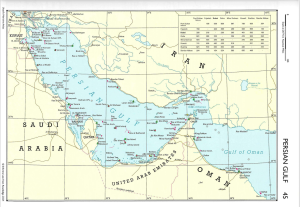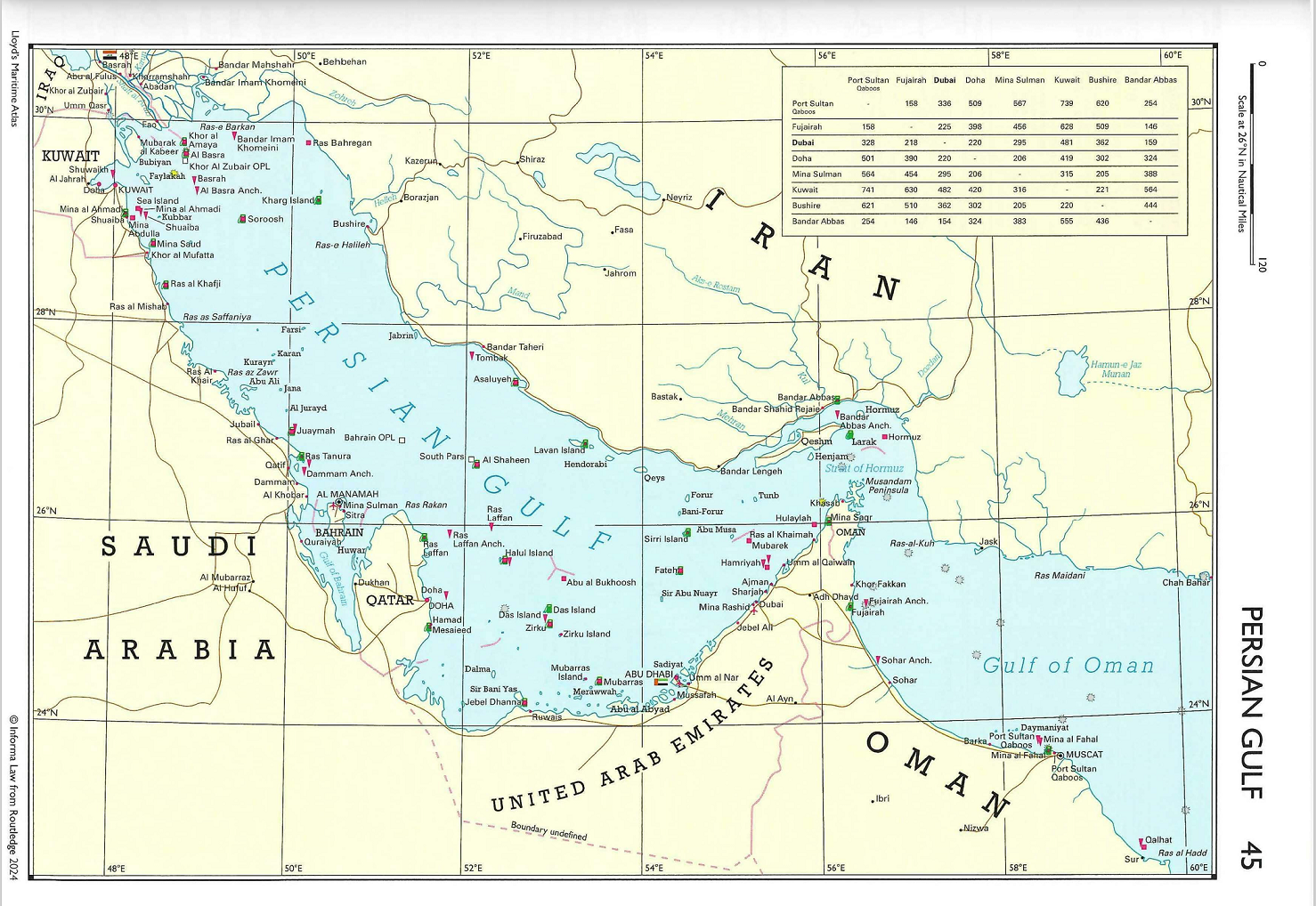
Explore the top 10 busiest ports in the Persian Gulf ranked by cargo throughput and capacity. Discover how these key maritime gateways drive global trade, energy logistics, and regional development.
Why Persian Gulf Ports Matter in Global Maritime Trade
The Persian Gulf, one of the world’s most strategically important maritime corridors, is far more than a body of water separating the Arabian Peninsula from Iran. It’s the beating heart of global energy logistics and a hub of diversified cargo flows that extend from Asia to Europe and beyond.
At the center of this dynamic region are ports—vast logistical complexes that handle everything from crude oil and liquefied natural gas (LNG) to cars, containers, and food staples. These aren’t just docking points. They’re sophisticated ecosystems equipped with smart port technologies, deep-water terminals, and massive storage yards.
According to the UNCTAD Review of Maritime Transport, the Gulf’s ports collectively handle over 400 million tonnes of cargo annually, with container volumes showing steady year-on-year growth. As global trade reroutes around conflicts in the Red Sea or bottlenecks at the Suez Canal, Persian Gulf ports are becoming even more vital.
This article ranks the top 10 busiest ports in the Persian Gulf based on recent capacity data, throughput, and strategic impact, with insights on their development, real-world role, and future outlook.
Ranking Criteria and Data Sources
Our ranking is based on the most recent publicly available data from:
- UNCTAD and World Bank port performance indicators
- Port authority annual reports
- Lloyd’s List Intelligence
- MarineTraffic and Clarksons Research
- Governmental trade statistics and port expansion plans (2023–2024)
Metrics considered include:
- Total cargo tonnage (dry bulk, liquid bulk, containers)
- TEU (Twenty-Foot Equivalent Unit) container throughput
- Number of vessel calls and berth productivity
- Strategic importance to global energy and shipping corridors
1. Jebel Ali Port (UAE)
Country: United Arab Emirates
Annual Throughput: ~14 million TEU; over 90 million tonnes of cargo
Operator: DP World
Located in Dubai, Jebel Ali is the undisputed giant of the Persian Gulf. As the largest man-made harbor in the world and the busiest port between Rotterdam and Singapore, it’s a global benchmark for port efficiency.
The port features:
-
67 berths across 3 container terminals
-
Seamless multimodal connectivity via Jebel Ali Free Zone (JAFZA)
-
One of the earliest adopters of blockchain-based trade platforms through DP World’s CARGOES
Its strategic position supports not just the UAE but GCC-wide trade, particularly with India, China, and East Africa.
2. Shahid Rajaee Port (Iran)
Country: Iran
Annual Throughput: ~1.5 million TEU; ~60 million tonnes total cargo
Operator: Ports and Maritime Organization (PMO)
Situated at the Strait of Hormuz in Bandar Abbas, Shahid Rajaee is Iran’s primary gateway to international trade. Despite sanctions, it handles a substantial portion of the country’s non-oil exports and imports.
Its significance lies in:
-
Deep-water access for 100,000+ DWT vessels
-
Dual-use terminals for general cargo and containers
-
Integrated link to Iran’s national rail system
Iran has recently modernized several terminals with automated cranes and electronic customs clearance to improve competitiveness.
3. King Abdulaziz Port, Dammam (Saudi Arabia)
Country: Saudi Arabia
Annual Throughput: ~2 million TEU; over 50 million tonnes of cargo
Operator: Saudi Ports Authority (MAWANI)
The largest port on Saudi Arabia’s Gulf coast, Dammam Port connects directly to Riyadh via the Saudi Railways Organization (SRO). It is vital for importing construction materials, foodstuffs, and industrial goods to support Vision 2030.
Notable developments:
-
New digital gate systems for faster truck movement
-
Expansion of container berths under a long-term concession with DP World
-
Regular container traffic with UAE, India, and China
4. Port of Sohar (Oman)
Country: Oman
Annual Throughput: Over 1.3 million TEU; ~45 million tonnes total
Operator: Sohar Industrial Port Company (joint venture with the Port of Rotterdam)
Located outside the Strait of Hormuz, Sohar has emerged as Oman’s leading multipurpose port. It’s an energy, logistics, and industrial hub, with direct hinterland connectivity to Oman’s Free Zones and Muscat.
Key features:
-
First Gulf port to adopt hydrogen-ready bunkering stations
-
Home to Vale’s iron ore pelletizing complex
-
Strong focus on green fuel terminals and LNG re-exports
5. Khalifa Port (UAE)
Country: United Arab Emirates
Annual Throughput: ~2.5 million TEU; over 35 million tonnes
Operator: AD Ports Group
Abu Dhabi’s flagship port, Khalifa, is one of the region’s smartest and fastest-growing maritime infrastructures. It serves the Khalifa Industrial Zone (KIZAD) and has a fully automated terminal operated by COSCO Shipping Ports.
In recent years:
-
China invested $300 million in additional berths
-
A dedicated ro-ro terminal supports car imports for the GCC
-
AD Ports is building links to the Etihad Rail freight network
6. Ras Laffan Port (Qatar)
Country: Qatar
Annual Throughput: Over 70 million tonnes (mainly LNG and condensates)
Operator: QatarEnergy
Ras Laffan isn’t a container port—it’s the world’s largest LNG export terminal. It plays a singular but massive role in global energy supply, especially to Europe and East Asia.
Highlights:
-
Handles more than 4,000 LNG vessel calls per year
-
Central to Qatar’s North Field Expansion, which will increase LNG output by 60% by 2027
-
Adjacent shipyard and logistics zone serve OSVs and LNG carriers
7. Shuwaikh Port (Kuwait)
Country: Kuwait
Annual Throughput: ~900,000 TEU; ~30 million tonnes of cargo
Operator: Kuwait Ports Authority
Shuwaikh is Kuwait’s principal commercial port, strategically located near Kuwait City. It handles a mix of containers, vehicles, breakbulk, and foodstuffs.
Upgrades in recent years include:
-
New container handling cranes from ZPMC
-
A digitized customs and port management platform
-
Climate resilience projects to counter sea-level rise
8. Hamad Port (Qatar)
Country: Qatar
Annual Throughput: ~1.7 million TEU; over 28 million tonnes
Operator: Mwani Qatar
Opened in 2016, Hamad Port is one of the most advanced deep-sea ports in the region. Post-2017 Gulf blockade, it became a symbol of Qatar’s trade independence.
Infrastructure includes:
-
Three container terminals, each with semi-automated RTGs
-
Direct links with India, Turkey, and Oman through new shipping lanes
-
Custom-built livestock and food terminals
9. Mina Zayed / Port Zayed (UAE)
Country: United Arab Emirates (Abu Dhabi)
Annual Throughput: ~15 million tonnes
Operator: AD Ports Group
While partially eclipsed by Khalifa Port, Mina Zayed remains crucial for traditional cargo, bulk shipments, and cruise tourism in Abu Dhabi.
Recent transformations:
-
Shift to serve as a logistics and cruise terminal
-
Refurbishment of bulk berths
-
Emerging role in humanitarian aid logistics (e.g., Yemen relief missions)
10. Mina Salman (Bahrain)
Country: Bahrain
Annual Throughput: ~300,000 TEU; ~10 million tonnes
Operator: APM Terminals Bahrain
Mina Salman, though smaller, plays a critical role in Bahrain’s economy. As the kingdom’s primary cargo port, it connects to the Khalifa Bin Salman Port (KBSP), offering modern container handling and ro-ro capabilities.
Projects include:
-
Expansion of free zone warehousing
-
Port digitization with blockchain pilot programs
-
Green energy integration with Bahrain’s 2035 Sustainability Plan
Real-World Impacts: Port-Driven Transformation
These ports are not isolated infrastructure—they shape how cities and nations function. For example:
-
Jebel Ali’s expansion catalyzed the growth of Dubai as a global logistics hub.
-
Hamad Port’s emergence enabled Qatar to rewire its supply chain after the blockade.
-
Sohar and Duqm Ports in Oman are helping shift the country from oil dependency to industrial diversification.
Additionally, Gulf ports are pioneering digital transformation. According to Thetius’ Smart Port Index, ports like Khalifa and Jebel Ali are integrating AI logistics platforms, drone surveillance, and digital twins to streamline cargo movement and improve safety.
FAQ: Persian Gulf Ports
What is the busiest port in the Persian Gulf?
Jebel Ali Port in Dubai is the busiest, handling over 14 million TEU annually.
Which Persian Gulf port exports the most LNG?
Ras Laffan Port in Qatar is the world’s largest LNG export terminal.
Are Gulf ports investing in green technologies?
Yes. Ports like Sohar, Khalifa, and Jebel Ali are implementing hydrogen bunkering, solar grids, and electric RTGs.
How do Persian Gulf ports connect to global trade?
Through maritime corridors linking Asia, Africa, and Europe. Ports often serve as transshipment hubs for East-West trade.
Which port is best for industrial exports?
Sohar and Khalifa Ports are particularly strong due to their integration with industrial free zones and rail networks.
What challenges do these ports face?
Geopolitical tensions, climate adaptation, labor availability, and keeping pace with digital transformation are key concerns.
Are Persian Gulf ports part of Belt and Road Initiative (BRI)?
Yes. Chinese investment is evident in Khalifa, Sohar, and others under the BRI framework.
Conclusion: Where the Desert Meets Global Trade
The top ports of the Persian Gulf are not just regional logistics hubs. They are global players shaping trade routes, energy flows, and the digital port revolution. From the desert shores of Qatar to the industrial cities of Iran, these ports are vital links in a complex maritime chain that keeps the world connected.
Whether you’re a shipping professional, a student of maritime logistics, or an enthusiast of port infrastructure, understanding these ports means grasping the pulse of global trade—and how it’s being reimagined in one of the world’s most dynamic maritime regions.

